Endosymbionts, Parasites, and Pathogens
Lopez RP, Díaz-Nieto LM, & Berón CM. 2016
Nuevo hospedador y distribución del parásito de mosquitos Strelkovimermis spiculatus [New host and distribution for the mosquito parasite Strelkovimermis spiculatus].
Revista de la Sociedad Entomologica Argentina 75, 101-104.
Strelkovimermis spiculatus Poinar & Camino 1986 (Nematoda: Mermithidae) was found parasitizing some mosquito genera as Aedes (Ochlerotatus), Culex and Psorophora. In a mosquito distribution project in Buenos Aires, Argentina, we found nematodes infecting mosquito larvae in natural breeding sites in the outskirts of Mar del Plata city. The aim of this work was to identify this parasite in this distribution area and determine the mosquito species host. COI and 18S rRNA-ITS1-5.8S rRNA-ITS2-28S rRNA gene fragments were described and were used for molecular identification of this nematode, confirming the morphological diagnostic traits. In this report, a new host of S. spiculatus, the mosquito larvae of Culex eduardoi was detected, expanding its southeastern distribution.
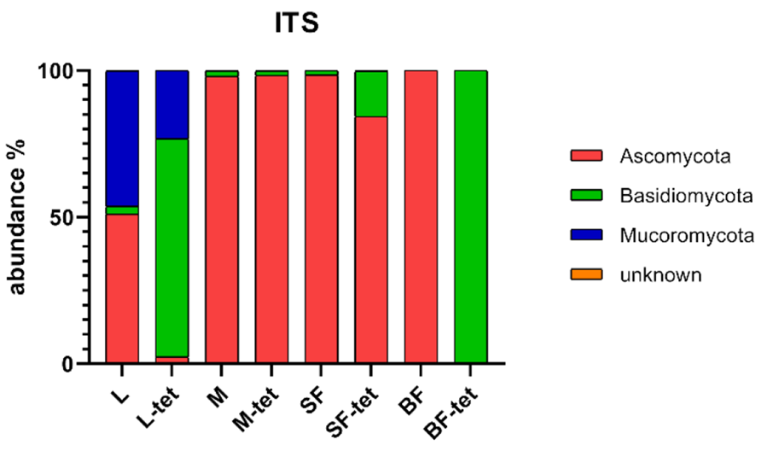


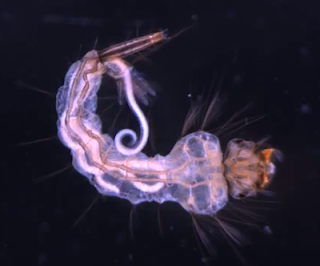
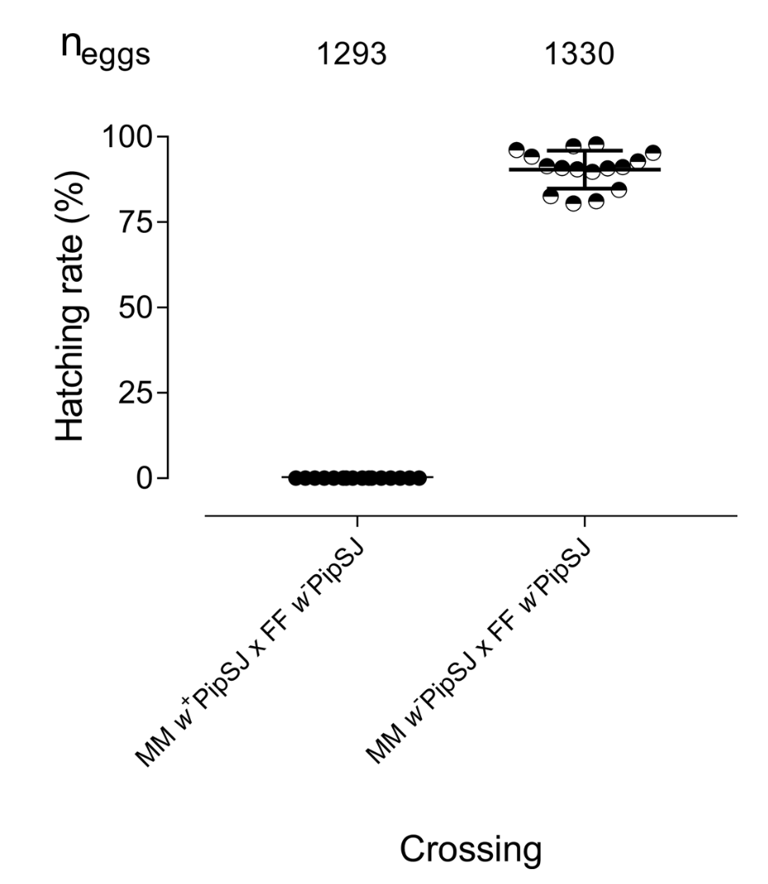

Flores GAM, Lopez RP, Cerrudo CS, Perotti MA, Consolo VF, & Berón CM. 2023
Wolbachia dominance influences the Culex quinquefasciatus microbiota.
Scientific Reports 13, 18980.
Microorganisms present in mosquitoes and their interactions are key factors affecting insect development. Among them, Wolbachia is closely associated with the host and affects several fitness parameters. In this study, the bacterial and fungal microbiota from two laboratory Culex quinquefasciatus isolines (wild type and tetracycline-cured) were characterized by metagenome amplicon sequencing of the ITS2 and 16S rRNA genes at different developmental stages and feeding conditions. We identified 572 bacterial and 61 fungal OTUs. Both isolines presented variable bacterial communities and different trends in the distribution of diversity among the groups. The lowest bacterial richness was detected in sugar-fed adults of the cured isoline, whereas fungal richness was highly reduced in blood-fed mosquitoes. Beta diversity analysis indicated that isolines are an important factor in the differentiation of mosquito bacterial communities. Considering composition, Penicillium was the dominant fungal genus, whereas Wolbachia dominance was inversely related to that of Enterobacteria (mainly Thorsellia and Serratia). This study provides a more complete overview of the mosquito microbiome, emphasizing specific highly abundant components that should be considered in microorganism manipulation approaches to control vector-borne diseases.
Díaz-Nieto LM, D'Alessio C, Perotti MA, & Berón CM. 2016
Culex pipiens development is greatly influenced by native bacteria and exogenous yeast.
PLoS ONE 11, e0153133.
Culex pipiens is the most cosmopolitan mosquito of the Pipiens Assemblage. By studying the nature of interactions between this species and microorganisms common to its breeding environment we can unravel important pitfalls encountered during development. We tested the survival rate of larval stages, pupae and adults of a Cx. pipiens colony exposed to a variety of microorganisms in laboratory conditions and assessed the transmission to offspring (F1) by those organisms that secured development up to adulthood. Three complementary experiments were designed to: 1) explore the nutritional value of yeasts and other microorganisms during Cx. pipiens development; 2) elucidate the transstadial transmission of yeast to the host offspring; and 3) to examine the relevance of all these microorganisms in female choice for oviposition-substratum. The yeast Saccharomyces cerevisiae proved to be the most nutritional diet, but despite showing the highest survival rates, vertical transmission to F1 was never confirmed. In addition, during the oviposition trials, none of the gravid females was attracted to the yeast substratum. Notably, the two native bacterial strains, Klebsiella sp. and Aeromonas sp., were the preferred oviposition media, the same two bacteria that managed to feed neonates until molting into 2nd instar larvae. Our results not only suggest that Klebsiella sp. or Aeromonas sp. serve as attractants for oviposition habitat selection, but also nurture the most fragile instar, L1, to assure molting into a more resilient stage, L2, while yeast proves to be the most supportive diet for completing development. These experiments unearthed survival traits that might be considered in the future development of strategies of Cx. pipiens control. These studies can be extended to other members of the Pipiens Assemblage.
Díaz-Nieto LM, Gil MF, Lazarte JN, Perotti MA, & Berón CM. 2021
Culex quinquefasciatus carrying Wolbachia is less susceptible to entomopathogenic bacteria.
Scientific Reports 11, 1094.
In an attempt to evaluate the susceptibility of the mosquito Culex quinquefasciatus to bacterial agents, a population naturally infected with a Wolbachia pipientis wPipSJ native strain was tested against the action of three bacterial mosquitocides, Bacillus thuringiensis subsp. israelensis, Bacillus wiedmannii biovar thuringiensis and Lysinibacillus sphaericus. Tests were carried out on mosquito larvae with and without Wolbachia (controls). Cx. quinquefasciatus naturally infected with the native wPipSJ strain proved to be more resistant to the pathogenic action of the three mosquitocidal bacterial strains. Additionally, wPipSJ was fully characterised using metagenome-assembled genomics, PCR–RFLP (PCR-Restriction Fragment Length Polymorphism) and MLST (MultiLocus Sequence Typing) analyses. This Wolbachia strain wPipSJ belongs to haplotype I, group wPip-III and supergroup B, clustering with other mosquito wPip strains, such as wPip PEL, wPip JHB, wPip Mol, and wAlbB; showing the southernmost distribution in America. The cytoplasmic incompatibility phenotype of this strain was revealed via crosses between wildtype (Wolbachia+) and antibiotic treated mosquito populations. The results of the tests with the bacterial agents suggest that Cx. quinquefasciatus naturally infected with wPipSJ is less susceptible to the pathogenic action of mosquitocidal bacterial strains when compared with the antibiotic-treated mosquito isoline and is more susceptible to B. thuringiensis subsp. israelensis than to the other two mosquitocidal agents.
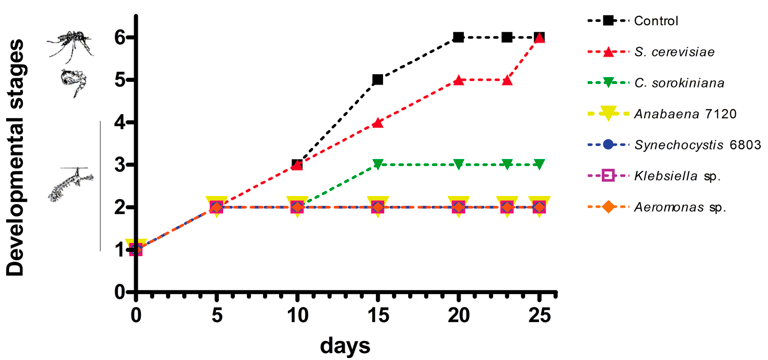

Martinez-Sañudo I, Perotti MA, Scaccini D, Pozzebon A, Marri L, & Mazzon L. 2020
Co-haplotyping symbiont and host to unravel invasion pathways of the exotic pest Halyomorpha halys in Italy.
Scientific Reports 10,18441.
The brown marmorated stink bug Halyomorpha halys (Stål) is a globally invasive species that harbours the primary bacterial symbiont ‘Candidatus Pantoea carbekii’. In this work, P. carbekii was used as another genetic marker to investigate the biodiversity and biogeographical patterns of this important pest, in native and newly invaded areas, especially in Italy. The correlation between the genetic structure of the symbiont and that of its host was studied through the analyses of one bacterial and one host marker, the putative pseudogene ΔybgF and the mitochondrial gene COI, respectively. As a result, five new P. carbekii haplotypes were identified, and an association pattern between host-symbiont haplotypes was observed. Host species showed higher haplotype diversity than symbiont, which can be expected in a long term host-symbiont association. Populations from the north-eastern Italy showed the highest values of genetic diversity for both markers, highlighting that this particular Italian area could be the result of multiple ongoing introductions. Moreover, some of the symbiont-host haplotypes observed were shared only by populations from north-eastern Italy and native areas, especially Japan, suggesting further introductions from this native country to Italy. Overall, our findings improve the understanding of the potential origin of multiple accidental introductions of H. halys in Italy.
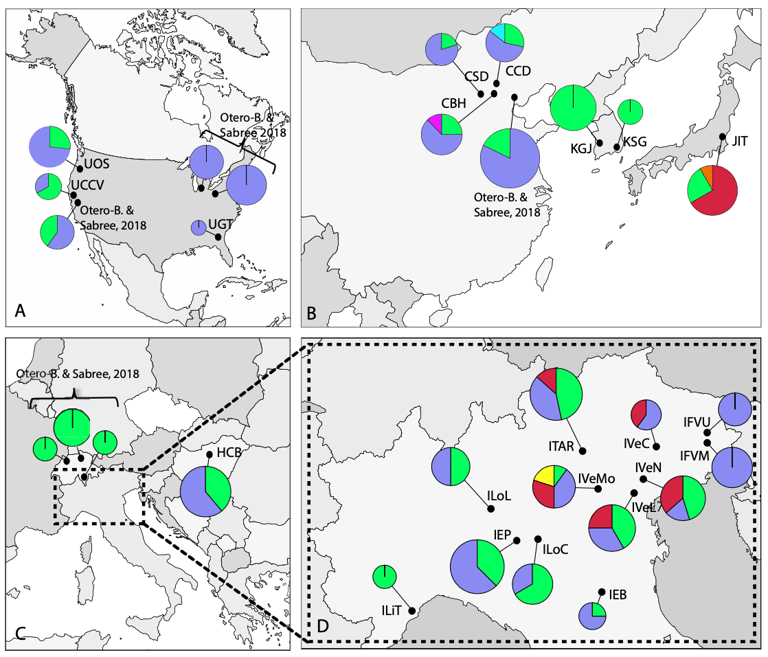

Image: Manar Sanad

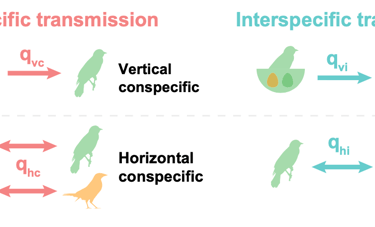

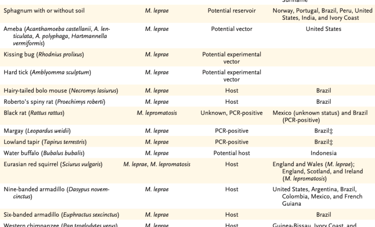
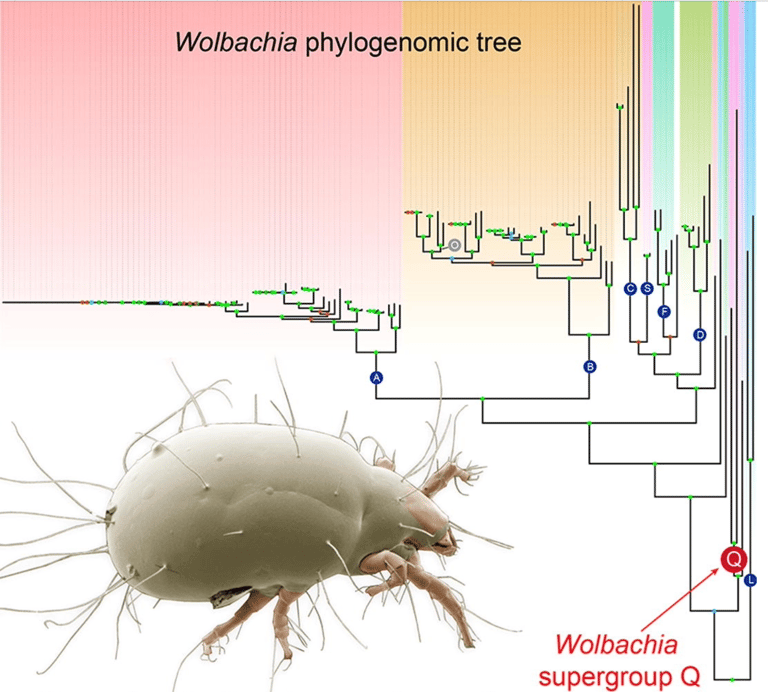

Pedroso LGA, Klimov PB, Mironov SV, OConnor BM, Braig HR, ..., & Hernandes FA, 2023
Horizontal transmission maintains host specificity and codiversification of symbionts in a brood parasitic host.
Communications Biology 6, 1171.
In host-symbiont systems, interspecific transmissions create opportunities for host switches, potentially leading to cophylogenetic incongruence. In contrast, conspecific transmissions often result in high host specificity and congruent cophylogenies. In most bird-feather mite systems, conspecific transmission is considered dominant, while interspecific transmission is supposedly rare. However, while mites typically maintain high host specificity, incongruent cophylogenies are common. To explain this conundrum, we quantify the magnitude of conspecific vs. interspecific transmission in the brood parasitic shiny cowbird (Molothrus bonariensis). M. bonariensis lacks parental care, allowing the assessment of the role of horizontal transmission alone in maintaining host specificity. We found that despite frequent interspecific interactions via foster parental care, mite species dispersing via conspecific horizontal contacts are three times more likely to colonize M. bonariensis than mites transmitted vertically via foster parents. The results highlight the previously underappreciated rate of transmission via horizontal contacts in maintaining host specificity on a microevolutionary scale. On a macroevolutionary scale, however, host switches were estimated to have occurred as frequently as codivergences. This suggests that macroevolutionary patterns resulting from rare events cannot be easily generalized from short-term evolutionary trends.
Pieters T, Meredith AL, & Braig HR, 2023
More on autochthonous leprosy in the United States.
New England Journal of Medicine 389, 963-964.
In a recent letter to the editor, Belzer et al. (June 29 issue) note that armadillos as a maintenance host cannot account for all current cases of autochthonous leprosy in the United States. Armadillos also die from the disease, and whether the pathogen is maintained permanently in wild populations of armadillos is undetermined. In addition to armadillos, other animal hosts have been discovered (Table 1). In particular, new findings in rodent species in Brazil indicate that still other potential hosts await discovery.
Primary infections from the environment and potential insect and tick vectors should be considered in addition to zoonotic infection. Water and soil should be considered as potentially important environmental reservoirs. Mycobacterium leprae can survive in the laboratory for 7 to 90 days, but amebas can sustain bacteria for up 35 days, and cysts of amebas can keep M. leprae alive for up to 8 months. The environmental reservoir of M. lepromatosis, the second species that causes leprosy, remains to be elucidated. Dual infections in humans have been reported in Brazil, Mexico, and Southeast Asia.
Klimov PB, Cui Y, Hubert J, Erban T, Perotti MA, Braig HR, ..., & Cui Y. 2024
Genomic and metagenomic analyses of the domestic mite Tyrophagus putrescentiae identify it as a widespread environmental contaminant and a host of a basal, mite-specific Wolbachia lineage (supergroup Q).
International Journal of Parasitology, 54, 661-674.
Tyrophagus putrescentiae (mould mite) is a global, microscopic trophic generalist that commonly occurs in various human-created habitats, causing allergies and damaging stored food. Its ubiquity and extraordinary ability to penetrate research samples or cultures through air currents or by active walking through tights spaces (such as treads of screw caps) may lead to sample contamination and introduction of its DNA to research materials in the laboratory. This prompts a thorough investigation into potential sequence contamination in public genomic databases. The trophic success of T. putrescentiae is primarily attributed to the symbiotic bacteria housed in specialized internal mite structures, facilitating adaptation to varied nutritional niches. However, recent work suggests that horizontal transfer of bacterial/fungal genes related to nutritional functionality may also contribute to the mite’s trophic versatility. This aspect requires independent confirmation. Additionally, T. putrescentiae harbors an uncharacterized and genetically divergent bacterium, Wolbachia, displaying blocking and microbiome-modifying effects. The phylogenomic position and supergroup assignment of this bacterium are unknown. Here, we sequenced and assembled the T. putrescentiae genome, analyzed its microbiome, and performed detailed phylogenomic analyses of the mite-specific Wolbachia. We show that T. putrescentiae DNA is a substantial source of contamination of research samples. Its DNA may inadvertently be co-extracted with the DNA of the target organism, eventually leading to sequence contamination in public databases. We identified a diversity of bacterial species associated with T. putrescentiae, including those capable of rapidly developing antibiotic resistance, such as Escherichia coli. Despite the presence of diverse bacterial communities in T. putrescentiae, we did not detect any recent horizontal gene transfers in this mite species and/or in astigmatid (domestic) mites in general. Our phylogenomic analysis of Wolbachia recovered a basal, mite-specific lineage (supergroup Q) represented by two Wolbachia spp. from the mould mite and a gall-inducing plant mite. Fluorescence in situ hybridization confirmed the presence of Wolbachia inside the mould mite. The discovery of an early derivative Wolbachia lineage (supergroup Q) in two phylogenetically unrelated and ecologically dissimilar mites suggests that this endosymbiotic bacterial lineage formed a long-term association with mites. This finding provides a unique insight into the early evolution and host associations of Wolbachia. Further discoveries of Wolbachia diversity in acariform mites are anticipated.
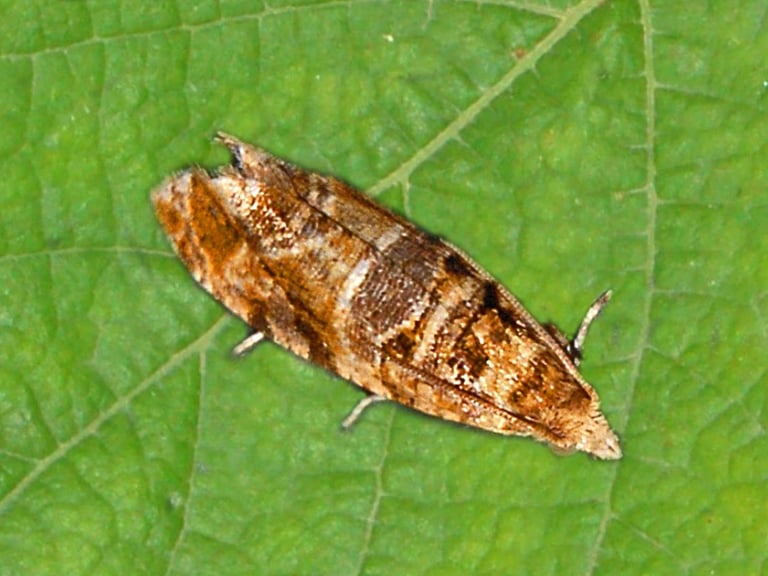

Díaz Nieto L M, Esteso C, Rull J, Flaqué V, Coria C, Murúa F A, & Kulichevsky L. 2024.
Molecular characterization and first report of Wolbachia strains of the European grapevine moth Lobesia botrana (Lepidoptera: Tortricidae) in populations from Argentina.
Phytoparasitica 53, 9.
The grapevine moth Lobesia botrana is a major pest of vineyards worldwide. Chemical insecticides and the sexual confusion technique are used to reduce damage. Several biological control approaches are being studied, including the use of the obligate intracellular bacteria Wolbachia, however, this method has been little explored. To use this bacterium for pest control it is necessary to know if the target pest is infected. The aim of this study was to examine Wolbachia infection in L. botrana populations from different vine growing areas of San Juan, Argentina. Lobesia botrana were captured in vineyards using sticky traps with pheromones. Wolbachia infection was diagnosed using a specific PCR test and fully characterized using Multi-Locus Sequence Typing (MLST) analyses. All populations tested were positive for Wolbachia, representing the first record of Wolbachia strains in grapevine moths from Argentina. The MLST analyses showed that Wolbachia strain belongs to supergroup B, clustering with other Wolbachia moth strains. More research is needed to understand the relationship between the grapevine moth and Wolbachia and how to use this to manage pests.
Berón CM, Díaz-Nieto LM, Lazarte JN, & Lopez RP. 2016
Bacterias como agentes de control biológico de poblaciones de mosquitos [Bacteria as biological control agents of mosquito populations].
In: Investigaciones sobre Mosquitos de Argentina [Research on Mosquitoes in Argentina]. Berón CM, Campos RE, Gleiser R, Díaz-Nieto LM, Salomón OD, & Schweigmann N (eds). Mar del Plata: Universidad Nacional de Mar del Plata; 251-268.
Hubert J, Kopecky J, Nesvorna M, Perotti MA, & Erban T. 2016
Detection and localization of Solitalea-like and Cardinium bacteria in three Acarus siro populations (Astigmata: Acaridae).
Experimental and Applied Acarology 70, 309-327.
Siozios S, Ioannidis P, Klasson L, Andersson SGE, Braig HR, & Bourtzis B. 2013
The diversity and evolution of Wolbachia ankyrin repeat domain genes.
PLoS ONE 8, e55390.
Kopecky J, Perotti MA, Nesvorna M, Erban T, & Hubert J. 2013
Cardinium endosymbionts are widespread in synanthropic mite species (Acari: Astigmata).
Journal of Invertebrate Pathology 112, 20-23.
Dubuffet A, Smith JE, Solter L, Perotti M A, Braig HR, & Dunn AM. 2013
Specific detection and localization of microsporidian parasites in invertebrate hosts by using in situ hybridization.
Applied and Environmental Microbiology 79, 385-388.
Saridaki A, Sapountzis P, Harris, HL, Batista PD, Biliske JA, Pavlikaki H, …, Braig HR, & Bourtzis K. 2012
Wolbachia prophage DNA adenine methyltransferase genes in different Drosophila-Wolbachia associations.
PLoS ONE 6, e19708.
Mukhopadhyay J, Braig HR, Rowton ED, & Gosh K. 2012
Naturally occurring culturable aerobic gut flora of adult Phlebotomus papatasi, vector of Leishmania major in the Old World.
PLoS ONE 7, e35748.
Hubert J, Kopecký J, Perotti MA, Nesvorná M, Braig HR, Ságová-Marečková M, ..., & Zurek L. 2012
Detection and identification of species-specific bacteria associated with synanthropic mites.
Microbial Ecology 63, 919-928.
Perotti MA & Braig HR. 2011
Eukaryotic ectosymbionts of Acari.
Journal of Applied Entomology 135, 514-523.
Lantova L, Ghosh K, Svobodova M, Braig HR, Rowton E, Weina P, Volf P, & Votypka J. 2010
The life cycle and host specificity of Psychodiella sergenti n. sp. and Ps tobbi n. sp. (Protozoa: Apicomplexa) in sand flies Phlebotomus sergenti and Ph. tobbi (Diptera: Psychodidae).
Journal of Invertebrate Pathology 105, 182-189.
Kirkness EF, Haas BJ, Sun W, Braig HR, Perotti MA, …, & Pittendrigh BR. 2010
Genome sequences of the human body louse and its primary endosymbiont provide insights into the permanent parasitic lifestyle
Proceedings of the National Academy of Sciences of the United States of America 107, 12168-12173.
Klasson L, Westberg J, Sapountzis P, Naesiund K, Lutnaes Y, Darby AC, Veneti, Z., Chen, L., Braig HR, …, & Andersson GE. 2009
The mosaic genome structure of the Wolbachia wRi strain infecting Drosophila simulans.
Proceedings of the National Academy of Sciences of the United States of America 106, 5725-5730.
Votypka J, Lantova L, Ghosh K, Braig HR, & Volf P. 2009
Molecular characterization of gregarines from sand flies (Diptera: Psychodidae) and description of Psychodiella n. g. (Apicomplexa: Gregarinida).
Journal of Eukaryotic Microbiology 56, 583-588.
Perotti MA, Kirkness EF, Reed DL, & Braig HR. 2009
Endosymbionts of lice.
In: Insect Symbiosis 3. Bourtzis K & TA Miller TA (eds.). Boca Raton: Taylor & Francis; 205-219.
Braig HR, Turner BD, & Perotti MA. 2009
Symbiotic Rickettsia.
In: Insect Symbiosis 3. Bourtzis K & TA Miller TA (eds.). Boca Raton: Taylor & Francis; 221-249
Allen JM, Light JE, Perotti MA, Braig HR, & Reed DL. 2009
Mutational meltdown in primary endosymbionts: Selection limits Muller's ratchet.
PLoS ONE 4, e4969.
Brennan LJ, Keddie BA, Braig HR, & Harris HL. 2008
The endosymbiont Wolbachia pipientis induces the expression of host antioxidant proteins in an Aedes albopictus cell line.
PLoS ONE 3, e2083.
Félix C, Grève P, Braquart-Varnier C, Braig HR, Pichon S, Cheng L, Garrett R, & Martin G,. 2008
Characterization and transcriptional analysis of two gene clusters for a type IV secretion machinery in Wolbachia of Armadillidium vulgare.
Research in Microbiology 159, 481-485.
Perotti MA, Allen JM, Reed DL, & Braig HR. 2007
Host-symbiont interactions of the primary endosymbiont of human head and body lice.
FASEB Journal 21, 1058-1066.
Allen JM, Reed DL, Perotti MA, & Braig HR. 2007
Evolutionary relationships of "Candidatus Riesia spp.," endosymbiotic Enterobacteriaceae living within hematophagous primate lice.
Applied and Environmental Microbiology 73, 1659-1664.
Perotti MA, Clarke HK, Turner BD, & Braig HR. 2006
Rickettsia as obligate and mycetomic bacteria.
FASEB Journal 20, 2372-2374.
Veneti Z, Bentley JK, Koana T, Braig HR, & Hurst GDD. 2005.
A functional dosage compensation complex required for male killing in Drosophila.
Science 307, 1461-1463.
Perotti MA, & Braig HR. 2005
Endosymbionts of Acari.
Phytophaga 14, 457-474.
Perotti MA, Catalá SS, Ormeño AD, Zelazowska M, Bilinski SM, & Braig HR. 2004
The sex ratio distortion in the human head louse is conserved over time.
BMC Genetics 5, e10.
Hamilton JV, Lehane MJ, & Braig HR. 2003
Isolation of Enterobacter sakazakii from midgut of Stomoxys calcitrans.
Emerging Infectious Diseases 9, 1355-1356.
Nirgianaki A, Banks GK, Frohlich D, Veneti Z, Braig HR, Miller TA, Bedford ID, Markham PG, Savakis C, & Bourtzis K,. 2003
Wolbachia infections of the whitefly Bemisia tabaci.
Current Microbiology 47, 93-101.
Vandekerckhove TTM, Watteyne S, Bonne W, Vanacker D, Devaere S, Rumes B, Maelfait JP, Gillis M, Swings JG, Braig HR, & Mertens J. 2003
Evolutionary trends in feminization and intersexuality in woodlice (Crustacea, Isopoda) infected with Wolbachia pipientis (alpha-Proteobacteria).
Belgian Journal of Zoology 133, 61-69.
Ono M, Braig HR, Munstermann LE, Ferro C, & O’Neill SL. 2001
Wolbachia infections of phlebotomine sand flies.
Journal of Medical Entomoloy 38, 237-241.
Rousset F, Braig HR, & O’Neill SL. 1999
A stable triple Wolbachia infection in Drosophila with nearly additive incompatibility effects.
Heredity 82 (1999), 620-627.
Dobson SL, Bourtzis K, Braig HR, Rousset F, Jones BF, Zhou W, & O’Neill SL. 1999
Wolbachia infections are distributed throughout insect somatic and germ line tissues.
Insect Biochemistry and Molecular Biology 28, 153-160.
Bourtzis K, Dobson SL, Braig HR, & O'Neill S. 1998
Rescuing Wolbachia have been overlooked.
Nature 391, 852-853.
Braig HR, Zhou W, Dobson S, & O’Neill SL. 1998
Cloning and characterization of a gene encoding the major surface protein of the bacterial endosymbiont Wolbachia.
Journal of Bacteriology 180, 2373-2378.
Sasaki T, Braig HR, & O’Neill SL. 1998
Analysis of Wolbachia protein synthesis in Drosophila in vivo.
Insect Molecular Biology 7, 101-105.
O'Neill SL, Pettigrew M, Sinkins SP, Braig HR, Andreadis TG, & Tesh RB. 1997
In vitro cultivation of Wolbachia pipientis in an Aedes albopictus cell line.
Insect Molecular Biology 6, 33-39.
Sinkins SP, Braig HR, & O'Neill SL. 1995
Wolbachia pipientis: bacterial density and unidirectional cytoplasmic incompatibility between infected populations of Aedes albopictus.
Experimental Parasitology 81, 284-291.
O'Neill SL, Kittayapong P, Braig HR, Andreadis TG, Gonzalez JP, & Tesh RB. 1995
Insect densoviruses may be widespread in mosquito cell lines.
Journal of General Virology 76, 2067-2074.
Sinkins SP, Braig HR, & O'Neill SL. 1995
Wolbachia superinfections and the expression of cytoplasmic incompatibility.
Proceedings of the Royal Society 261 B, 325-330.
Braig HR, Guzman H, Tesh RB, & O'Neill SL. 1994
Replacement of the natural Wolbachia symbiont of Drosophila simulanswith a mosquito counterpart.
Nature 367, 453-455.
Thiele B, Braig HR, Ehm I, Kunze R, & Ruf B. 1989
Influence of sulfated carbohydrates on the accessibility of CD4 and other CD molecules on the cell surface and implication for human immunodeficiency virus infection.
European Journal of Immunology 19, 1161-1164.
Diringer H & Braig HR. 1989
Infectivity of unconventional viruses in dura mater.
The Lancet, 1 (8635), 439-440.
Czub M, Braig HR, & Diringer H. 1988
Replication of the scrapie agent in hamsters infected intracerebrally confirms the pathogenesis of an amyloid-inducing virosis.
Journal of General Virology 69 (1988), 1753-1756.
Czub M, Braig HR, & Diringer H. 1986
Pathogenesis of scrapie: Study of the temporal development of clinical symptoms, of infectivity titres, and scrapie-associated fibrils in brains of hamsters infected intraperitonealy.
Journal of General Virology 67 (1986), 2005-2009.
Czub M, Braig HR, Blode H, & Diringer H. 1986
The major protein of SAF is absent from spleen and thus not an essential part of the scrapie agent.
Archives in Virology 91, 383-386.
Braig HR & Diringer, H. 1985
Scrapie - Concept of a virus-induced amyloidosis of the brain.
EMBO Journal 4, 2309-2312.